Business aviation has had a long love affair with Asia. The vast continent has been a slow burner in terms of aircraft sales, but the pace of growth has quickened over the past decade and the potential for further expansion is enormous. According to Flightglobal's Ascend database, the installed base of business jets used in corporate and private service has climbed from a meagre 68 aircraft in 2000 to nearly 470 today. Growth gathered pace in 2004 and since then has recorded a year-on-year increase of around 25%.
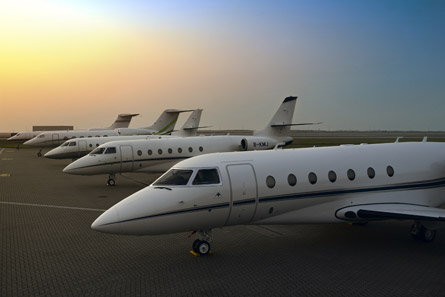 |
|---|
© MetroJet Hong Kong's oldest charter and management company MetroJet is looking at locations and partnerships for new ventures in mainland China |
The jewel in Asia's crown is arguably Greater China. This region - which includes Hong Kong, Macau, Taiwan and mainland China - has become a lifeline for many embattled business aviation companies. When swathes of the Western world were in the grip of a devastating economic downturn in 2008 and 2009, China was experiencing breathtaking GDP growth of 10% thanks to its booming industrial sector - from mining and machine-building to textiles and transportation. This in turn has created a cornucopia of thriving companies and ultra-high-net-worth individuals with a healthy appetite for business aviation.
This development is borne out by Flightglobal's Ascend data, which shows a meteoric rise in the tally of Greater China-registered business jets from 10 in 2000 to nearly 170 today (excluding those in military and utility service). Several foreign-registered aircraft are also based in the region.
Manufacturers, suppliers and service providers - still reeling from the financial meltdown in their traditional markets of the USA and Europe - are eager to claim a slice of this huge pie. For many observers the Greater China market is still is in its genesis and the potential for business aviation here is enormous.
"The market is still in its infancy," says Björn Näf, chief executive of Hong Kong's oldest charter and management company MetroJet. "The Greater China business-jet fleet is very small compared with other regions, but the country is waking up to the benefits of business aviation and the outlook is promising.'
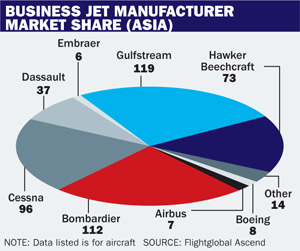 |
|---|
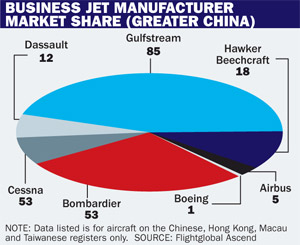 |
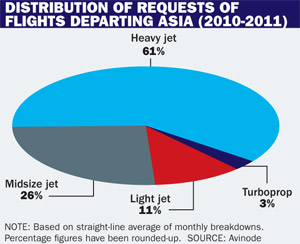 |
Rousing the affectionately named "sleeping giant" has taken some time, but "OEMs [original equipment manufacturers] are predicting deliveries of hundreds of business aircraft to Greater China over the next ten years, with 50 jets a year forecast for Mainland China alone," says Näf.
The most sought-after aircraft are the long-range, large-cabin types, notably Gulfstream's G450 and G550 and Bombardier Global family. Niche VIP airliners such as the Airbus Corporate Jetliner and the Boeing Business Jets line-up are also appearing more regularly on the shopping lists of wealthy Chinese consumers.
"Buyers here are typically after new business jets direct from the OEM," says Jeff Lowe, general manager with aviation consultancy Asian Sky. "There is a mistrust of brokers and few buyers have ever used escrow agents" - which are regularly involved in aircraft transactions in the West.
The heady days of widespread choice and availability could be coming to an end, Lowe cautions. "Accessing new aircraft hasn't been a problem for the last few years as there have been fewer buyers on the market," he adds. "But now the global market for large cabin jets is picking up, OEM order backlogs are getting longer."
Chinese buyers are easily persuaded to look at "near-new" pre-owned aircraft - recently delivered aircraft with fewer than 100h on the clock, Lowe admits. "Such is the demand for these jets that some sellers are now getting premiums for their aircraft," he says.
Even for the ad-hoc users across Asia, however, the top-end jets are the aircraft of choice, according to the latest data supplied by online charter booking company Avinode. "Online charter enquiries reveal a marked difference in popularity between the bottom and top end of the business aircraft spectrum," says the company, whose database contains a growing fleet of 80 aircraft belonging to operators across the region.
LARGE-CABIN DEMAND
While top-of-the-range jets are the aircraft of choice for many buyers and users, smaller, super-midsize and midsize aircraft are now starting to arouse interest.
"Here is one of the trends we are seeing," says Lowe. "The company chairman buys a brand new G550 for personal, security and business reasons. He is so impressed with the benefits the aircraft provides that he acquires a second aircraft - a smaller G450 or Dassault Falcon 2000 for example - to push the benefits down to company level."
With the inventory of business jets in Greater China predicted to soar to over 1,000 aircraft by 2020, the region's operators and service providers are eager to expand.
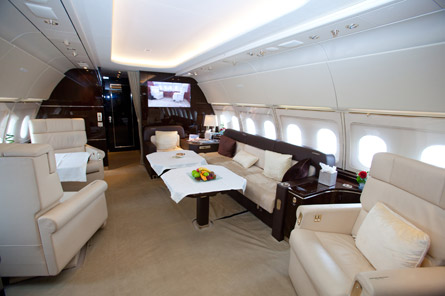 |
|---|
© Airbus Niche VIP airliners such as Airbus ACJs are appearing more regularly on the shopping lists of wealthy Chinese consumers |
"The advantages of setting up a base on the mainland are clear," says Christof Späth, Jet Aviation's senior vice president of maintenance, repair and overhaul and fixed-base operations for Europe, the Middle East, Africa and Asia. "Although Hong Kong is part of [the People's Republic of] China, we are not allowed to manage or maintain aircraft that are registered in mainland China," he says. "Once you have the approvals to operate on the mainland there are so many opportunities available." Jet Aviation now manages 20 aircraft from its base in Hong Kong and is eager to make its move into China. "The market there is so young that many of the owners are new to business aviation. They have little knowledge of operating aircraft and need the help of management companies.'
Jet Aviation - which also has a maintenance, research and overhaul (MRO) facility in Singapore - is in talks with a Chinese partner, Späth says, and plans to set up an operation "on the east side, which covers Beijing and Shanghai".
Fellow charter and management company MetroJet also has its sights on mainland China. "We are looking at various locations and partnerships, but we don't have a timeframe for the new venture," says Näf. He admits the barriers faced by operators of non-B registered aircraft are frustrating. "Not only can we not maintain B-registered aircraft in Hong Kong, but we are also classified as a foreign operator. This has a direct impact on our operational flexibility," he adds.
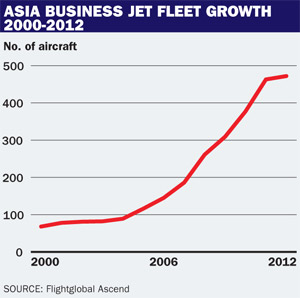 |
|---|
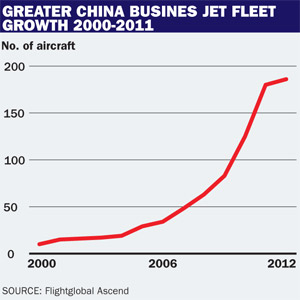 |
Lowe agrees. "There are a host of advantages to having a Chinese aircraft operator's certificate," he says. Flight permits, for example, take less than 24h to process as they only need approval from the local Civil Aviation Administration of China (CAAC) office. For foreign-registered aircraft the permits can take up to three days, as approval is required from the CAAC headquarters. The permit application requires letters of invitation from all destination and Chinese sponsors and access is limited to international airports in China - only 45 out of 180. Here charges and fees are up to ten times higher for foreign-registered aircraft and the cost of fuel has a typical levy of 35% for non-B-registered aircraft. "Foreign-registered aircraft are subject to slot controls in both Beijing and Shanghai airport," says Lowe.
For those operators already established on the mainland, the path to growth is no less fraught. Business Aviation Asia (BAA), which has bases in Hong Kong and Tianjin, says its hopes of swelling its fleet of 29 privately-owned business jets by 50% this year are being curtailed by unnecessary, lengthy bureaucracy. The six-year-old company has about 15 mainly large-cabin and long-range business jets awaiting delivery. "You can apply to import up to three aircraft [at once] on [one] application at a time, and the process should take about three months per application," says Leung. "We have noticed this timeframe has been widening gradually, and today it can take us up to nine months to complete. The delays have a domino effect on other applications."
Lowe says importing aircraft has always been a lengthy process in China, but with the increased number of aircraft being sold to Chinese nationals, the timescale has increased. "The process can take a minimum of eight months," says Lowe. He explains. Even when the CAAC's regional office has reviewed the application, it still has to be scrutinised by nine different government departments at the CAAC's headquarters in Beijing. If it is approved, it is then sent to the regional office for further approval. Finally, the aircraft's arrival in China must be co-ordinated with the regional office to ensure a CAAC engineer from this office is present to sign off all the required documents and certification. Unfortunately there are only six qualified CAAC engineers available."
Such bureaucratic headaches will take time to cure, but there is a genuine will on the part of the Chinese government to improve the infrastructure for business and general aviation. The country's Twelfth Five-Year Plan cites aviation reform as a key priority between 2011 and 2015, and improvements are already being introduced. For example, the country is slowly opening up sections of low-altitude airspace to general aviation traffic, while investment in the country's business aviation infrastructure - including fixed base operations and MRO facilities - is starting to take shape.
According to the Chinese zodiac calendar, 2012 is the Year of the Water Dragon - marking a year of transition, uncertainty and change. An uncanny coincidence perhaps? China is in for a bumpy ride this year as it navigates the economic and political headwinds created by much slower GDP growth and a leadership change within the ruling party. These factors will inevitably have repercussions for the business aviation industry, but whether they will quell its optimism remains to be seen.
- Watch Siva Govindasamy's video report on business aviation in the Asia-Pacific region
Source: Flight International



















